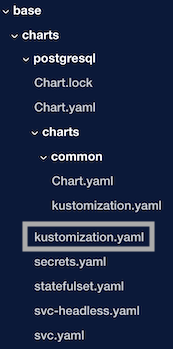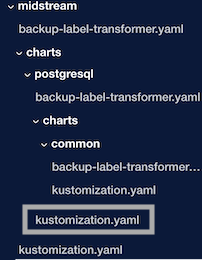How the App Manager Processes Helm Charts
Native Helm
Our Native Helm feature utilizes the Helm binary to deploy charts instead of kubectl apply. This helps support Helm lifecycle instruments such as Helm Hooks and Weights.
Processing Helm charts for the app manager is accomplished with five high-level steps:
1) Check for Previous Installations of the Chart
The app manager checks previous versions of the installed app, checking if the chart has been installed previously without Native Helm.
This step ensures the app manager will not attempt a Native Helm install of a chart that has already been deployed by the app manager without Native Helm. If this check fails, the following error will be displayed:
Deployment method for chart <chart> has changed
Note: We do not yet support migrating existing app installations to Native Helm installations. Until migrations are supported, the recommended path is removing the application from the Replicated App Manager and installing fresh with Native Helm. PVCs will be removed in the process -- because this will cause data loss, it is strongly encouraged that application maintainers ensure they have an out-of-band backup and restore method before attempting to migrate live production installs from the previous helm implementation to a native helm one. Because Replicated's built-in snapshot and restore tooling also restores deployed application manifests, it is not a suitable solution for this migration problem.
2) Write Base Files
The Helm manifests are extracted, rendered with Replicated templating, and added to base/charts.
Replicated's HelmChart spec can be modified to allow the ConfigOptions to overwrite a chart's values. This allows vendors to surface a chart's value options inside the Replicated Config page. After Replicated templating is processed on the values.yaml file, all files from the original Helm tarball are written to the base/charts/ directory, maintaining the original directory structure of the Helm Chart. A kustomization.yaml file is included in each chart and sub chart directory. This is used later to merge kustomization instructions up to the chart resources.
Example
In this example, a base directory is illustrated and the base/charts/postgresql/kustomization.yaml targets chart resources:

apiVersion: kustomize.config.k8s.io/v1beta1
kind: Kustomization
resources:
- secrets.yaml
- statefulset.yaml
- svc-headless.yaml
- svc.yaml
3) Write Midstream Files
The midstream directory contains Replicated kustomize instructions for all deployed resources, such as imagePullSecrets, image proxies, and backup labels.
The directory structure in base/charts is copied to overlays/midstream/charts. Replicated searches all manifests for private images. These images are added to a kustomization.yaml file, which is written at the chart or subchart level matching the resource being kustomized. For example, if the postgres image is found at base/charts/postgres/templates/deployment.yaml, the kustomization.yaml to overwrite the image will be added to overlays/midstream/charts/postgres/kustomization.yaml. This midstream kustomization has a bases entry that points to the corresponding kustomization.yaml file from base. Other midstream kustomizations are processed here as well, such as backup label transformers and image pull secrets. They are appended to the same file as above for each chart and subchart.
Example
In this example, a midstream directory is illustrated and the overlays/midstream/charts/postgresql/kustomization.yaml adds Replicated customization:

apiVersion: kustomize.config.k8s.io/v1beta1
bases:
- ../../../../base/charts/postgresql
commonAnnotations:
kots.io/app-slug: native-helm-test
images:
- name: gcr.io/replicated-qa/postgresql
newName: proxy.replicated.com/proxy/native-helm-test/gcr.io/replicated-qa/postgresql
kind: Kustomization
patchesStrategicMerge:
- pullsecrets.yaml
resources:
- secret.yaml
transformers:
- backup-label-transformer.yaml
4) Write Downstream Files
Replicated allows last-mile customization on Helm resources using downstream kustomize files.
As above, the directory structure in base/charts is copied to overlays/downstream/this-cluster/charts. Each chart and subchart directory receives a kustomization.yaml. These files only have bases defined, which points to the corresponding midstream kustomization file from step 3. These downstream kustomization.yaml files can be edited before deploying the application. Any kustomize instructions here will take priority over midstream and base kustomizations.
Example
In this example, a downstream directory is illustrated and the overlays/downstream/this-cluster/charts/postgresql/kustomization.yaml provides a template for last-mile overrides:

apiVersion: kustomize.config.k8s.io/v1beta1
bases:
- ../../../../midstream/charts/postgresql
kind: Kustomization
5) Deploy Helm Chart
Replicated leverages the Helm binary to install the fully-rendered chart resources.
When deploying the application, Replicated walks the overlays/downstream/charts directory looking for kustomization.yaml files. Upon finding them, the app manager will run kustomize build on the files. The resulting manifests are packaged together into a new tarball for Helm to consume.
The app manager finally runs helm upgrade -i chart.tar.gz. The helm binary processes hooks and weights, applies manifests to the Kubernetes cluster, and saves a release secret similar to sh.helm.release.v1.chart-name.v1. This secret is how Helm tracks upgrades and rollbacks of applications.
Replicated KOTS
The Replicated KOTS Helm installation is compatible with both Helm v2 and Helm v3 as it does not rely on Tiller to deploy the chart into the cluster. Instead, the Replicated app manager treats a Helm Chart as the packaging spec rather than the deployment tool. The Replicated Helm installation creates deployable YAML by leveraging the same functionality that the helm template command uses, with some extended functionality for specific Helm hooks.
Replicated finally runs the following command: helm upgrade -i chart.tar.gz --timeout 60m -n {namespace}. The helm binary processes hooks and weights, applies manifests to the Kubernetes cluster, and saves a Release secret similar to sh.helm.release.v1.chart-name.v1. This secret is how Helm tracks upgrades and rollbacks of applications.
When a Helm chart-based application is installed in an air gap environment, the processing of the chart is managed in the end customer environment (with the kots CLI or as part of the Replicated admin console). This means that the customer supplied values, license values, and existing values can be used to create the deployable manifests. For more information, see builder in HelmChart.
In both online and air gap scenarios, the resulting deployment is comprised of raw Kubernetes manifests. Therefore, cluster operator's are always able to view the exact difference between what is currently deployed and what the update will deploy. This level of change management provides the necessary transparency to provide the level of assurance that cluster operators require.
Replicated App Manager Versioning Considerations
To determine if Helm v2 is necessary, the app manager will check the apiVersion supplied in the Chart.yaml file of the Helm chart. If Chart.yaml is not supplied or apiVersion is not present, the app manager will use Helm v3 to process all Helm charts to create deployable YAML.
Optionally, you can specify the Helm version in the HelmChart custom resource. Valid options are v2 and v3. For more information, see HelmChart in the Custom resources section.
Support for Helm v2, including security patches, ended on November 13, 2020. If you specify helmVersion: v2 in any HelmChart custom resources, update your references to v3. Replicated will remove support for Helm v2 in the near future.